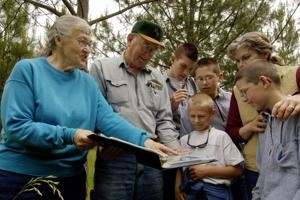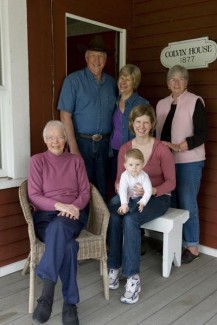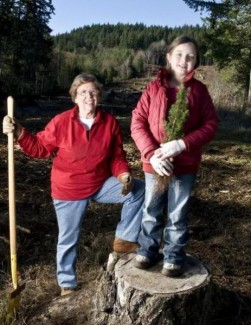
For a majority of woodland owners leaving a land legacy for the next generation is an important ownership objective. Less than half of those who feel that way will successfully create such a legacy. This is sad because most of them could.
If so many owners want to leave a legacy yet so few do, what’s going wrong? There are two pitfalls that can keep woodland owners from achieving their legacy objectives. The first is a failure to plan.Too many heirs are forced to sell all or part of the land they inherit to pay estate taxes. But an even bigger pitfall is a failure to appreciate that transition to the next generation is not an event that happens after you die. It is, or should be, a process that begins many years before you lay your mortal body to rest.
Simply transferring your woodland to the next generation won’t create a legacy. Estate planning allows for a smooth transfer of ownership, but it takes succession planning to achieve a legacy. Clint Bentz, C.P.A. I work with, sees what too often happens to families and woodlands when there is a lack of succession planning, “…brothers suing sisters; timber harvested prematurely; families torn apart by dissension; and lifetimes of hopes and dreams ending in confusion, sorrow and bitterness. Most heirs either split the property or have big fights and buy each other out if they can or sell the property if they can’t.” To be successful at leaving a woodland legacy, there are key areas that must be addressed. The good news is that you can start your succession planning right away and most of what needs to be done won’t involve hiring advisors.
Determine Your Purpose
Selling the land and leaving your heirs cash is by far the easiest way to go. So why do you want to leave a woodland legacy? How do you hope your legacy will benefit future generations? What are your hopes for the future of the land? Thinking through these questions and writing down your answers is the first step in the process of creating a land legacy. This is your vision and it is what should drive all your future planning including your estate plan.
Start Talking
There’s little or no communication in most families about inheritance. Yet, there’s so much to talk about. Let your family know what is important to you by sharing your hopes for the future. Let them know what you do in and with your woods. Let them share with you what’s important to them. Family meetings are a great forum for these conversations. Woodland owners Lon and Laura Rankin recently talked to me about how important family meetings are for them. Tips on how to get the conversation started are shared in another post.
Establish Ties to the Land
It’s never too soon or too late to help your heirs develop ties to the land. When your heirs have no such ties, they are likely to view the land as a financial asset. Most people would rather have cash or invest their money in an asset that delivers higher or quicker yields than woodland. Growing up on the land is frequently how such ties are established. But perhaps you got your woodland after your heirs were grown. You can create an almost instant attachment to the land by naming natural features such as streams, waterfalls, or unique areas after family members. Another possibility is to create opportunities for recreational activities that make it fun to spend time in the woods. Brenda Woodard and her husband host a family get together on the property each year. For other ideas, see the Tips for Involving the Next Generation handout on the Ties to the Land website.
Create a Process for Making Decisions
In the context of succession planning, management not only includes what you’re doing with your woodland but also things like building maintenance and paying taxes. Right now you get to make all these decisions and see that things get done, but who will do it in the future? Answering that question now will contribute to an orderly succession.
If you have more than one heir, they will need to work together in the future to answer questions such as these: What should our policy be regarding income (if any) the property generates? What activities will we allow on the property? What is our policy about bringing guests onto the property? Establishing a good decision-making process now can smooth the transition by allowing your heirs to focus on management decisions rather than how those decisions will be made or who gets to make them.
See Your Attorney
Now that you’ve clarified you vision for the future of your woodlands, started communicating about it, learned more about your heirs’ ties to the land, and established processes for decision making and management it’s time to plan for the orderly transfer of ownership. There are many ways to legally accomplish such transfers – by sale, bequest, trust, limited liability company to name just a few. Woodland owners often come to our Ties to the Land succession planning workshops hoping to learn which way is best. The first thing I tell them is that there is no single best way. Each family is unique, so there is no such thing as a one-size-fits-all estate plan. That’s why it is critical to work with good advisors.
Yes, you need professional advice. How much will it cost? The cost will vary depending on the situation. In general, the more complex your situation, the more the process will cost. But this is not a time to consider fill-in-the blank legal forms. Everything you’re working toward hinges on appropriate legal documents worded specifically for your situation. When you consider the cost of creating a succession plan, remember experience shows that leaving this for your heirs to sort out is stressful, can lead to financial losses—and, all too often, life-long rifts between family members.
Leaving a woodland legacy takes planning. There are many resources available to help you. You can find many helpful resources on the Ties to the Land website. One of the highlights of my job is hearing from woodland owners about their succession planning experiences. Whether they’re just starting or stewards of a woodland legacy in its fifth generation, they all have experiences to share. So I thought I’d end with some words from them that I hope will motivate you to begin your planning.
“We found out almost all of the extended family wants to keep the land! We plan to have reunions every three years with discussion of issues all together.”
“It [succession planning] is helping us focus and get closer to being on the same page.”
“Our family meetings (annual business meeting) are fun and keep members interested and aware of ongoing tree farm activities, needs, planning, objectives. I am involving them in management decisions and activities when opportunities and schedules permit.”
“The process has enriched family communication – positively! The siblings and their kids are more active, they have instigated participated in several projects, i.e. tree trimming, spreading gravel on driveway, making the outdoor fire pit, safer as well as work on the buildings. The intention remains to use the land for our family recreation. “
What succession planning story would you share to motivate other women? Do you have an idea for helping the next generation create ties to the land?





